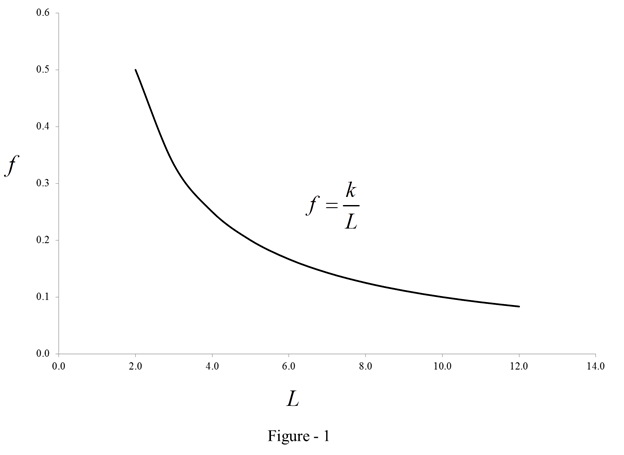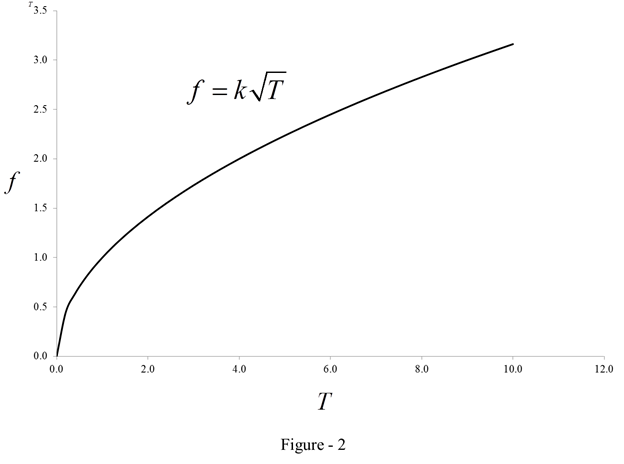
(a)
(i)
To find: The rate of change of the frequency with respect to the length (When
(a)
(i)
Answer to Problem 28E
The rate of change of frequency with respect to length is
Explanation of Solution
Given:
The frequency of vibrations of a vibrating violin string is as given below.
Calculation:
Calculate the rate of change of frequency with respect to length when
Differentiate the equation (1) with respect to
Thus, the rate of change of frequency with respect to length is
(i)
To find: The rate of change of the frequency with respect to the length (When
(i)
Answer to Problem 28E
The rate of change of frequency with respect to length is
Explanation of Solution
Given:
The frequency of vibrations of a vibrating violin string is as given below.
Calculation:
Calculate the rate of change of frequency with respect to length when
Differentiate the equation (1) with respect to
Thus, the rate of change of frequency with respect to length is
(ii)
To find: The rate of change of the frequency with respect to the tension (When
(ii)
Answer to Problem 28E
The rate of change of frequency with respect to tension is
Explanation of Solution
Calculate the rate of change of frequency with respect to tension when
Differentiate the equation (1) with respect to
Thus, the rate of change of frequency with respect to tension is
(iii)
To find: The rate of change of the frequency with respect to the linear density (When
(iii)
Answer to Problem 28E
The rate of change of frequency with respect to linear density is
Explanation of Solution
Calculate the rate of change of frequency with respect to linear density when
Differentiate the equation (1) with respect to
Thus, the rate of change of frequency with respect to linear density is
(b)
(i)
To find: To determine the behavior of pitch of the note “when the effective length of a string is decreased by placing a finger on the string is decreased by placing a finger on the string so a shorter portion of the string vibrates”.
(b)
(i)
Answer to Problem 28E
The pitch of the note is higher.
Explanation of Solution
Determine the behavior of the pitch note when the effective length of a string is decreased.
Sketch the curve.
Calculate the value of
Here
Substitute 1 for
Similarly, calculate the remaining values of
Calculate and tabulate the remaining values of
| 1 | 2 | 0.5 |
| 1 | 3 | 0.3 |
| 1 | 4 | 0.25 |
| 1 | 5 | 0.2 |
| 1 | 6 | 0.17 |
| 1 | 7 | 0.14 |
| 1 | 8 | 0.12 |
| 1 | 9 | 0.11 |
| 1 | 10 | 0.1 |
| 1 | 11 | 0.09 |
Graph:
Plot the graph using table (1) as shown in figure (1).

Comments:
Refer the figure (1).
Here the frequency of vibration
(i)
To find: To determine the behavior of pitch of the note “when the effective length of a string is decreased by placing a finger on the string is decreased by placing a finger on the string so a shorter portion of the string vibrates”.
(i)
Answer to Problem 28E
The pitch of the note is higher.
Explanation of Solution
Determine the behavior of the pitch note when the effective length of a string is decreased.
Sketch the curve.
Calculate the value of
Here
Substitute 1 for
Similarly, calculate the remaining values of
Calculate and tabulate the remaining values of
| 1 | 2 | 0.5 |
| 1 | 3 | 0.3 |
| 1 | 4 | 0.25 |
| 1 | 5 | 0.2 |
| 1 | 6 | 0.17 |
| 1 | 7 | 0.14 |
| 1 | 8 | 0.12 |
| 1 | 9 | 0.11 |
| 1 | 10 | 0.1 |
| 1 | 11 | 0.09 |
Graph:
Plot the graph using table (1) as shown in figure (1).

Comments:
Refer the figure (1).
Here the frequency of vibration
(ii)
To find: To determine the behavior of pitch of the note “When the tension is increased by turning a tuning peg.”.
(ii)
Answer to Problem 28E
The pitch of the note is higher.
Explanation of Solution
Determine the behavior of the pitch note when the tension is increased by turning a tuning peg.
Sketch the curve.
Calculate the value of
Here
Substitute 1 for
Similarly, calculate the remaining values of
Calculate and tabulate the remaining values of
| 1 | 0.0 | 0.0 |
| 1 | 0.2 | 0.4 |
| 1 | 0.4 | 0.6 |
| 1 | 0.6 | 0.8 |
| 1 | 0.8 | 0.9 |
| 1 | 1.0 | 1.0 |
| 1 | 1.2 | 1.1 |
| 1 | 1.4 | 1.2 |
| 1 | 1.6 | 1.3 |
| 1 | 1.8 | 1.3 |
| 1 | 2.0 | 1.4 |
| 1 | 2.2 | 1.5 |
| 1 | 2.4 | 1.5 |
| 1 | 2.6 | 1.6 |
| 1 | 2.8 | 1.7 |
| 1 | 3.0 | 1.7 |
| 1 | 3.2 | 1.8 |
| 1 | 3.4 | 1.8 |
| 1 | 3.6 | 1.9 |
| 1 | 3.8 | 1.9 |
| 1 | 4.0 | 2.0 |
| 1 | 4.2 | 2.0 |
| 1 | 4.4 | 2.1 |
| 1 | 4.6 | 2.1 |
| 1 | 4.8 | 2.2 |
| 1 | 5.0 | 2.2 |
| 1 | 5.2 | 2.3 |
| 1 | 5.4 | 2.3 |
| 1 | 5.6 | 2.4 |
| 1 | 5.8 | 2.4 |
| 1 | 6.0 | 2.4 |
| 1 | 6.2 | 2.5 |
| 1 | 6.4 | 2.5 |
| 1 | 6.6 | 2.6 |
| 1 | 6.8 | 2.6 |
| 1 | 7.0 | 2.6 |
| 1 | 7.2 | 2.7 |
| 1 | 7.4 | 2.7 |
| 1 | 7.6 | 2.8 |
| 1 | 7.8 | 2.8 |
| 1 | 8.0 | 2.8 |
| 1 | 8.2 | 2.9 |
| 1 | 8.4 | 2.9 |
| 1 | 8.6 | 2.9 |
| 1 | 8.8 | 3.0 |
| 1 | 9.0 | 3.0 |
| 1 | 9.2 | 3.0 |
| 1 | 9.4 | 3.1 |
| 1 | 9.6 | 3.1 |
| 1 | 9.8 | 3.1 |
| 1 | 10.0 | 3.2 |
Graph:
Plot the graph using table (2) shown in figure (2).

Comments:
Refer the figure (2).
Here the frequency of vibration
(iii)
To find: To determine the behavior of pitch of the note “When the linear density is increased by switching to another string”.
(iii)
Answer to Problem 28E
The pitch of the note is lower.
Explanation of Solution
Determine the behavior of the pitch note when the linear density is increased by switching to another string.
Sketch the curve.
Calculate the value of
Here
Substitute 1 for
Similarly, calculate the remaining values of
Calculate and tabulate the remaining values of
| 1 | 0.2 | 2.2 |
| 1 | 0.4 | 1.6 |
| 1 | 0.6 | 1.3 |
| 1 | 0.8 | 1.1 |
| 1 | 1.0 | 1.0 |
| 1 | 1.2 | 0.9 |
| 1 | 1.4 | 0.8 |
| 1 | 1.6 | 0.8 |
| 1 | 1.8 | 0.7 |
| 1 | 2.0 | 0.7 |
| 1 | 2.2 | 0.7 |
| 1 | 2.4 | 0.6 |
| 1 | 2.6 | 0.6 |
| 1 | 2.8 | 0.6 |
| 1 | 3.0 | 0.6 |
| 1 | 3.2 | 0.6 |
| 1 | 3.4 | 0.5 |
| 1 | 3.6 | 0.5 |
| 1 | 3.8 | 0.5 |
| 1 | 4.0 | 0.5 |
| 1 | 4.2 | 0.5 |
| 1 | 4.4 | 0.5 |
| 1 | 4.6 | 0.5 |
| 1 | 4.8 | 0.5 |
| 1 | 5.0 | 0.4 |
| 1 | 5.2 | 0.4 |
| 1 | 5.4 | 0.4 |
| 1 | 5.6 | 0.4 |
| 1 | 5.8 | 0.4 |
| 1 | 6.0 | 0.4 |
| 1 | 6.2 | 0.4 |
| 1 | 6.4 | 0.4 |
| 1 | 6.6 | 0.4 |
| 1 | 6.8 | 0.4 |
| 1 | 7.0 | 0.4 |
| 1 | 7.2 | 0.4 |
| 1 | 7.4 | 0.4 |
| 1 | 7.6 | 0.4 |
| 1 | 7.8 | 0.4 |
| 1 | 8.0 | 0.4 |
| 1 | 8.2 | 0.3 |
| 1 | 8.4 | 0.3 |
| 1 | 8.6 | 0.3 |
| 1 | 8.8 | 0.3 |
| 1 | 9.0 | 0.3 |
| 1 | 9.2 | 0.3 |
| 1 | 9.4 | 0.3 |
| 1 | 9.6 | 0.3 |
| 1 | 9.8 | 0.3 |
| 1 | 10.0 | 0.3 |
Graph:
Plot the graph using table (3) as shown in figure (3).

Comments:
Refer the figure (3).
Here the frequency of vibration
Chapter 3 Solutions
Single Variable Calculus: Concepts and Contexts, Enhanced Edition
 Calculus: Early TranscendentalsCalculusISBN:9781285741550Author:James StewartPublisher:Cengage Learning
Calculus: Early TranscendentalsCalculusISBN:9781285741550Author:James StewartPublisher:Cengage Learning Thomas' Calculus (14th Edition)CalculusISBN:9780134438986Author:Joel R. Hass, Christopher E. Heil, Maurice D. WeirPublisher:PEARSON
Thomas' Calculus (14th Edition)CalculusISBN:9780134438986Author:Joel R. Hass, Christopher E. Heil, Maurice D. WeirPublisher:PEARSON Calculus: Early Transcendentals (3rd Edition)CalculusISBN:9780134763644Author:William L. Briggs, Lyle Cochran, Bernard Gillett, Eric SchulzPublisher:PEARSON
Calculus: Early Transcendentals (3rd Edition)CalculusISBN:9780134763644Author:William L. Briggs, Lyle Cochran, Bernard Gillett, Eric SchulzPublisher:PEARSON Calculus: Early TranscendentalsCalculusISBN:9781319050740Author:Jon Rogawski, Colin Adams, Robert FranzosaPublisher:W. H. Freeman
Calculus: Early TranscendentalsCalculusISBN:9781319050740Author:Jon Rogawski, Colin Adams, Robert FranzosaPublisher:W. H. Freeman
 Calculus: Early Transcendental FunctionsCalculusISBN:9781337552516Author:Ron Larson, Bruce H. EdwardsPublisher:Cengage Learning
Calculus: Early Transcendental FunctionsCalculusISBN:9781337552516Author:Ron Larson, Bruce H. EdwardsPublisher:Cengage Learning





